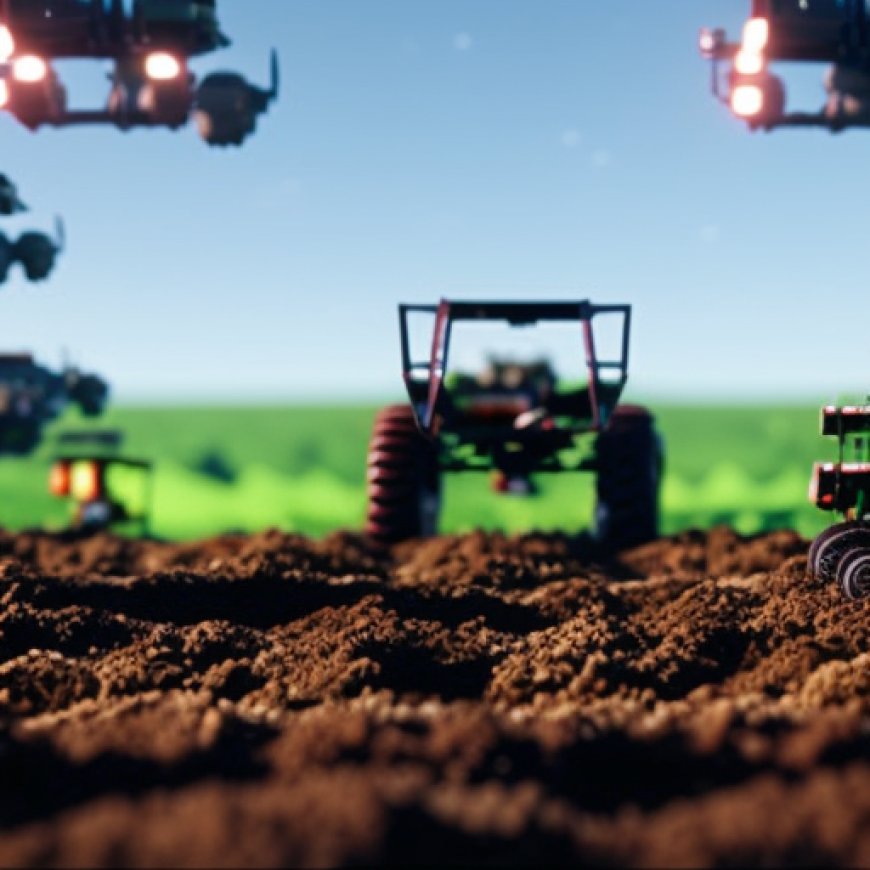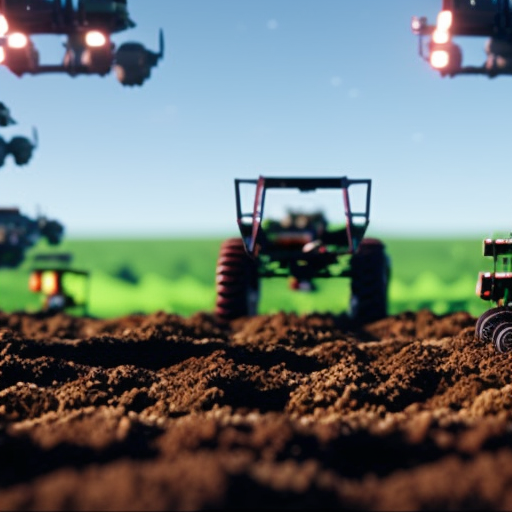FarmRobotix drives practical autonomous agricultural systems
FarmRobotix drives practical autonomous agricultural systems Farmers Review Africa


The DLG Launches FarmRobotix Platform at DLG Feldtage Trade Fair

The DLG (German Agricultural Society) is launching its new FarmRobotix platform at the DLG Feldtage trade fair, which will take place from 11 to 13 June at the estate Brockhof in the heart of the Soester Börde in Germany, a highly fertile region thanks to the depth of its loess soils.
FarmRobotix offers an international platform for farmers and experts seeking compact and comprehensive information on the latest developments in robotics, AI, automation and digital solutions in crop production. Aimed at farmers, manufacturers, start-ups and technology providers, FarmRobotix also offers representatives from science and research as well as development engineers, investors and venture capitalists the opportunity to network, share knowledge and explore innovative technologies.
This technical article shows where the greatest challenges currently lie in the application of digital and autonomous technologies in crop farming – and what contribution the FarmRobotix platform can make to solving these issues.
Platform goal: More user-friendliness for digital tools
“There are currently a large number of digital solutions available to farmers for various crop cultivation tasks,” explains Florian Schiller, an expert in digitalisation at the International DLG Crop Production Centre (IPZ) in Bernburg, Saxony-Anhalt. “However, their application requires prior knowledge on part of the user. This is because each provider of digital solutions typically supplies a customised software system for using the digital tools and the data. For agricultural farming entrepreneurs, this means that the number of software applications they need to master potentially increases with every digital tool they introduce on their farm,” explains Schiller. “The FarmRobotix platform can play a role in providing impetus in the dialogue between farmers, manufacturers and science in order to make the digital applications of different manufacturers compatible with each other,” adds Schiller.
Robotics solutions for large-scale farming
Another important issue for robotics in general is the large-scale application on farm land. There are already robotic solutions for seeding and for mechanical crop protection. However, according to Schiller, these are generally applications that are used on a small scale. “An important question for the future is therefore how robotics or autonomous solutions can be integrated into our existing system of arable land management, which is geared towards efficiency,” says Schiller.
Used in agriculture both in animal housing and outdoors, in the fields, robotics can have different degrees of automation, ranging from systems that work partially autonomously but are still dependent on human operation to fully autonomous solutions.
Partially autonomous agricultural systems are used in crop cultivation, for example as robotic systems in mechanical and chemical crop protection with small robots or in large machines with sensor-based individual nozzle control. There are also robotic systems for seeding, fertilising and soil cultivation. In animal husbandry, autonomous systems are mainly used as milking robots, autonomous feed mixers and feeding and cleaning systems.
AI in agriculture requires highly specialised training
In contrast to some other industries, the use of autonomous systems in agriculture is still at the pilot and research stage. This is mainly due to the fact that an agricultural robot has to perform more complex tasks than a robot used in industrial production, for example.
DLG’s expert Florian Schiller explains the complexity involved for robots in crop cultivation. DLG’s IPZ farm is part of several research projects on digitalisation and AI in crop production, including the NaLamKI project funded by Germany’s Federal Ministry of Economic Affairs.
NaLamKI stands for Sustainable Agriculture with AI. The research project aims at developing AI services for agriculture, which can analyse data from conventional and autonomous agricultural machinery, satellites and drones, combine them in a software service platform and make the results accessible through open interfaces. As an associated partner in the project, the IPZ is working on the early detection of fungal diseases in wheat using AI. Other project partners include the Fraunhofer Institute for Telecommunications (Heinrich Hertz Institute, HHI), the agricultural machinery manufacturer John Deere and the University of Hohenheim.
For Florian Schiller, the NaLamKI project shows once again that there is still a great need for research before AI can be applied on a large scale in agriculture. Schiller explains this with the high cost of data collection, which is necessary for some applications in plant cultivation. This is because AI needs a large amounts of training data for certain crop cultivation applications to make a practical contribution. One example is the area of fungal disease detection.
Challenge: differentiating between a wide range of properties
The aim of AI-supported detection of fungal diseases, which is being researched in the NaLamKI project,
SDGs, Targets, and Indicators
1. Which SDGs are addressed or connected to the issues highlighted in the article?
- SDG 2: Zero Hunger – The article discusses the use of digital and autonomous technologies in crop farming, which can contribute to improving agricultural efficiency and productivity.
- SDG 9: Industry, Innovation, and Infrastructure – The article highlights the development and application of robotics, AI, automation, and digital solutions in crop production.
- SDG 12: Responsible Consumption and Production – The article mentions the goal of making agricultural entrepreneurs’ day-to-day operational work more efficient, simpler, and less time-consuming through the use of digital technologies.
- SDG 15: Life on Land – The article discusses the integration of robotics and autonomous solutions into existing systems of arable land management for improved efficiency.
2. What specific targets under those SDGs can be identified based on the article’s content?
- SDG 2.4: By 2030, ensure sustainable food production systems and implement resilient agricultural practices that increase productivity and production, that help maintain ecosystems, that strengthen capacity for adaptation to climate change, extreme weather, drought, flooding, and other disasters, and that progressively improve land and soil quality.
- SDG 9.5: Enhance scientific research, upgrade the technological capabilities of industrial sectors in all countries, in particular developing countries, including, by 2030, encouraging innovation and substantially increasing the number of research and development workers per 1 million people and public and private research and development spending.
- SDG 12.3: By 2030, halve per capita global food waste at the retail and consumer levels and reduce food losses along production and supply chains, including post-harvest losses.
- SDG 15.3: By 2030, combat desertification, restore degraded land and soil, including land affected by desertification, drought, and floods, and strive to achieve a land degradation-neutral world.
3. Are there any indicators mentioned or implied in the article that can be used to measure progress towards the identified targets?
- Indicator for SDG 2.4: Productivity of agriculture measured by yield per hectare.
- Indicator for SDG 9.5: Number of research and development workers per 1 million people.
- Indicator for SDG 12.3: Amount of food waste generated at the retail and consumer levels.
- Indicator for SDG 15.3: Extent of land degradation and restoration measures implemented.
Table: SDGs, Targets, and Indicators
| SDGs | Targets | Indicators |
|---|---|---|
| SDG 2: Zero Hunger | 2.4: By 2030, ensure sustainable food production systems and implement resilient agricultural practices that increase productivity and production, that help maintain ecosystems, that strengthen capacity for adaptation to climate change, extreme weather, drought, flooding, and other disasters, and that progressively improve land and soil quality. | Productivity of agriculture measured by yield per hectare. |
| SDG 9: Industry, Innovation, and Infrastructure | 9.5: Enhance scientific research, upgrade the technological capabilities of industrial sectors in all countries, in particular developing countries, including, by 2030, encouraging innovation and substantially increasing the number of research and development workers per 1 million people and public and private research and development spending. | Number of research and development workers per 1 million people. |
| SDG 12: Responsible Consumption and Production | 12.3: By 2030, halve per capita global food waste at the retail and consumer levels and reduce food losses along production and supply chains, including post-harvest losses. | Amount of food waste generated at the retail and consumer levels. |
| SDG 15: Life on Land | 15.3: By 2030, combat desertification, restore degraded land and soil, including land affected by desertification, drought, and floods, and strive to achieve a land degradation-neutral world. | Extent of land degradation and restoration measures implemented. |
Behold! This splendid article springs forth from the wellspring of knowledge, shaped by a wondrous proprietary AI technology that delved into a vast ocean of data, illuminating the path towards the Sustainable Development Goals. Remember that all rights are reserved by SDG Investors LLC, empowering us to champion progress together.
Source: farmersreviewafrica.com

Join us, as fellow seekers of change, on a transformative journey at https://sdgtalks.ai/welcome, where you can become a member and actively contribute to shaping a brighter future.







